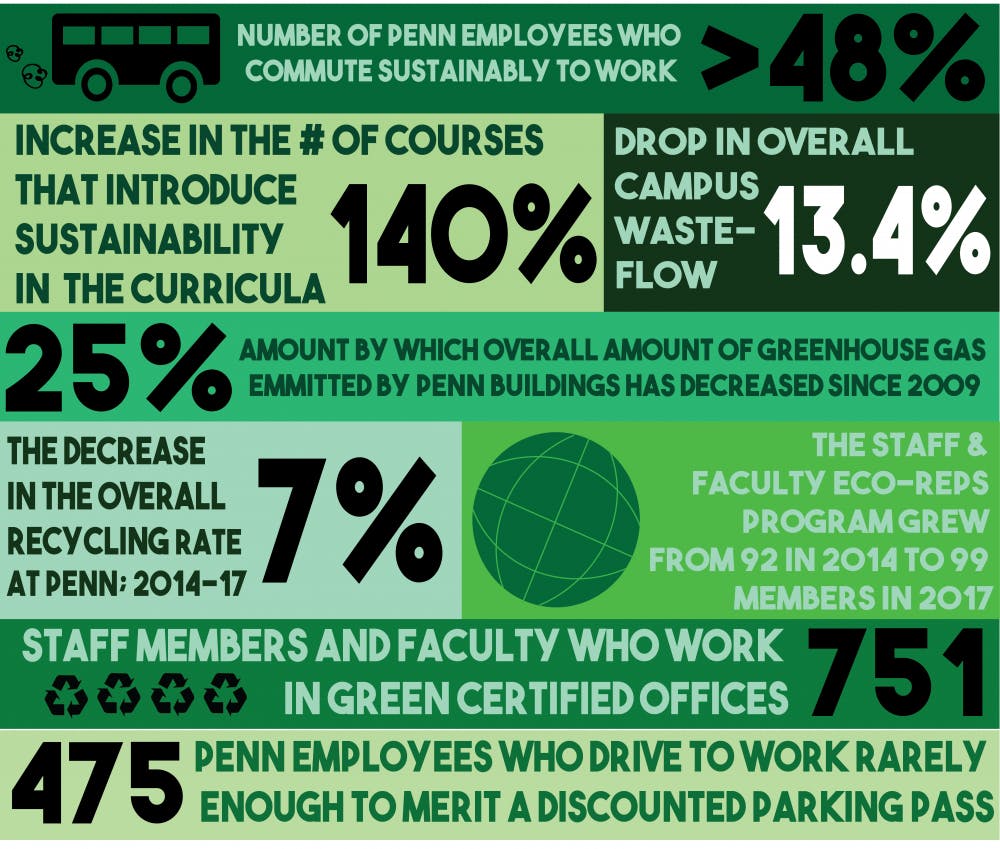
According to a recent report released by the University, Penn has rapidly become a more sustainable and environmentally-conscious campus in the last decade. But experts say that Penn still does not measure up to many other American institutions.
The report — which was published by Penn Sustainability, a “University-wide initiative” devoted to promoting sustainability on campus — suggests that the University has exceeded the goals set in 2014 by the University's Climate Action Plan 2.0 to improve Penn’s environmental consciousness. It serves as a mid-way report to evaluate Penn's progress.

The report conducted an assessment of the University's progress on seven fronts, including academics, utilities and operations, physical environment, transportation, waste minimization and recycling, purchasing, and outreach and engagement. In five out of these seven categories, Penn has made progress, the report states.
Although the report notes strong progress in categories like Penn's academic emphasis on environmental sustainability — with the University offering nearly 300 courses with sustainability in their curriculum, a 140 percent increase from 2014 — there are several categories where Penn falls short.
The sustainability report does not take into account Penn's fossil fuel assets that it holds through its endowment investment in many companies, experts say. However, this is a metric that is used by the Sierra Club, the country's largest and most influential grassroots environmental organization, in its annual "Cool Schools" ranking.
According to Sierra Magazine Editor Katie O'Reily, who was involved in creating the organization's ranking methodology, the ranking measures American universities and their commitment to sustainability across a broad range of factors. Penn included several of these measures in its report, including transportation, innovation, waste, and water, while excluding others such as investment in fossil fuels.
Penn's investment in fossil fuels has sparked strong activism on campus over the last few years. Fossil Free Penn, a student group founded three ago, has consistently pushed for the University's divestment from fossil fuels, staging multiple sit-ins on campus and protesting at University trustee meetings.
But little has changed since its founding. Penn has continued to maintain $315 million in fossil fuel assets in equities alone, or roughly 4 percent of the total endowment, according to FFP.
“Our metrics mirror the Sierra Club’s priorities so investment is one of the categories that we weigh pretty heavily," O'Reily said. "That is one of the most important things we think you could do to prevent climate change.”
Penn has not been in the top 200 schools of the Sierra Club's "Cool Schools" rankings in recent years.
The University also only saw "mixed success" in the category of utilities and operations. Even though the overall amount of greenhouse gases emitted from Penn buildings has decreased relative to the size of the school, Penn's energy consumption has risen due to the installment of new steam-driven chillers meant to cool off Penn's facilities.
Maddy Schuh, the sustainability analyst for Penn's Facilities and Real Estate Services, who led the collection of data for this report, said the installment of these chillers, though, will eventually lead to the usage of more efficient energy.
Julian Dautremont-Smith, the director of programs for the Association for the Advancement of Sustainability in Higher Education — a company that seeks to help universities achieve better sustainability practices — said that the 13 percent decrease in greenhouse gas emissions from Penn buildings since 2014 is a "significant" accomplishment.
"It’s not necessarily like ‘amazing, never been done before,’ but it's a solid achievement and they definitely deserve credit for the work they’ve done," Dautremont-Smith said. "There are campuses that are reporting larger decreases in their emissions over time."
O'Reily also noted the extent to which other universities have set goals far higher than Penn in terms of reducing greenhouse gas emissions.
“That [13 percent] seems commendable but some of our top schools have put in goals to put out zero emissions by 2020 or 2025,” O’Reilly said. “That tends to be impressive.”
The 4 percent increase in overall energy use, despite being temporary, also sets Penn off-track and could prevent it from reaching its intended goals by 2019.
While the report primarily suggested that Penn is on track to meet or exceed the goals set in CAP 2.0, it did note a surprising decrease in the overall recycling rate at Penn from 27 percent in 2014 to 20.2 percent in 2017.
Schuh said this decrease is not likely to indicate reduced recycling at Penn. Since the recycling rate is determined by the total weight of the recycled products, a commercial shift to lighter materials has simply decreased that weight.
“This decrease is in part due to the diminishing weight of recyclables, industry trends toward lighter packaging, and the efforts of Penn Purchasing to reduce packaging material brought to campus,” Schuh said.
Jisoo Kim, a student coordinator of Penn's Eco-Rep program, pointed out that despite the massive changes occurring at an institutional level reflected in this report, the most effective changes have occurred on a smaller scale.
“There are so many smaller changes that fly under the radar and people don’t really notice,” Kim said. “These are small impact changes — not necessarily flashy — but students work really hard and they make real change."
Penn's Undergraduate Chair for the Environmental Sciences Department Alain Plante said that Penn has shown serious commitment to fulfilling its environmental goals.
“This is not green-washing or all talk. There are really serious efforts being made to continually improve green efforts on campus," Plante said. “The University is acting as a model citizen.”
The Daily Pennsylvanian is an independent, student-run newspaper. Please consider making a donation to support the coverage that shapes the University. Your generosity ensures a future of strong journalism at Penn.
Donate






